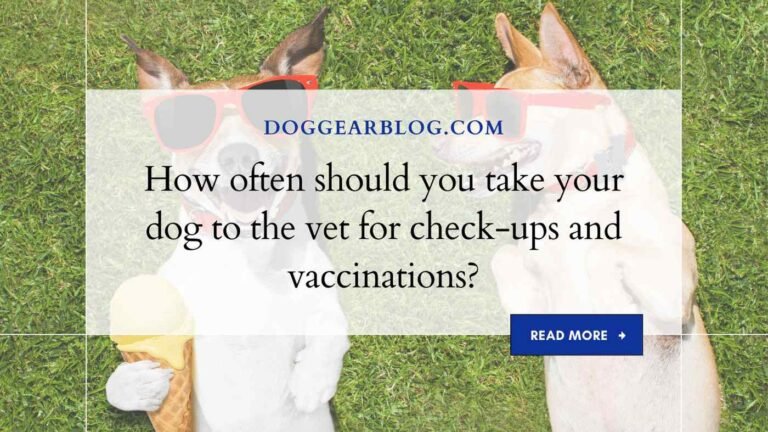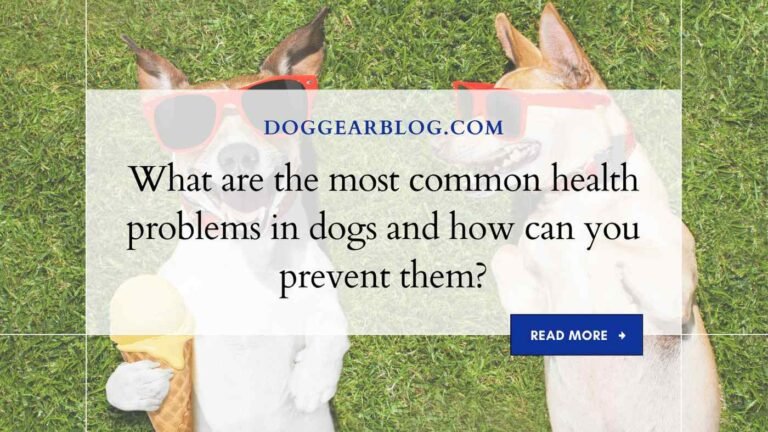What are some common eye and ear problems in dogs and how can you treat them?
As a dog parent, keeping your furry friend healthy and happy is a top priority. However, just like humans, our pups can experience an array of health issues – one of the most common being eye and ear problems. Whether it’s excessive discharge, itching or discomfort, these issues can cause significant distress to your pooch if left untreated.
But don’t worry! In this blog post, we’ll dive into some of the most common eye and ear problems in dogs and provide useful tips on how to treat them effectively. So sit tight with your pup by your side as we explore everything you need to know about keeping their eyes and ears sparkling clean!
Types of Eye Disorders in Dogs

There are a number of different eye disorders which can occur in dogs. These can range from minor problems such as redness or discharge to more serious conditions such as intense pain, blindness or even glaucoma. Each dog is unique and will therefore require a different approach when treating them, but some common methods include medication, surgery, laser treatment and acupuncture.
Some common eye problems in dogs include:
–Redness or discharge: This may be a sign of infection, irritation or inflammation and should be treated accordingly.
–Eye itching: This may be caused by various factors, such as pollen allergies, fleas or bacteria. Treatment may include topical corticosteroids or antihistamines.
–Excessive tearing: This may be due to various factors such as allergies, medications or pollution. Treatment may involve sedation if the condition is severe and/or artificial tears to relieve discomfort.
Types of Ears Disorders in Dogs
There are a number of conditions that can affect the ears and eyes in dogs.
Here are some of the more common ones:
The most common type of ear disorder is external otitis, which is an inflammation or infection of the outer ear. Symptoms include discharge from the ear, itchiness, and a change in eating or drinking habits.
Treatment includes antibiotics and pain relief medication. Other types of ear problems include deafness (incomplete hearing loss), drumhead Ear (a condition where one or both ears sticks out from the head), and secondary Otitis (another type of ear infection). Many times these problems can be treated with antibiotics and pain relief medications. If the problem is deafness, surgery may be required to implant a hearing device in the dog’s ear.
Dental issues can also cause issues with the ears, includingForeign Body Inclusion (EBIs), which is when small pieces of dental material become stuck in the dog’s eardrums, as well as Gingivitis (gum disease), which can cause an abscess on one or both gums near the dog’s mouth. Both dental problems can require antibiotics and pain relief medication to treat..
Dogs with eye problems typically experience decreased vision, glare, sensitivity to light/sensitivities to dust/dirt/fumes, redness/inflammation around the eyes, and difficulty making eye contact with people. Some common eye disorders include Dry Eye Syndrome (DES), canine Euthanasia Syndrome (CES), Retinal Atrophy (RA), and Glaucoma.
Some of the more common eye disorders include Canine Cataracts (CCs), Conjunctivitis (pink/green eyes), Mydriasis (small pupil size), POA (Pupillary Obstruction Syndrome; when one or both pupils does not respond normally to light or accommodation), and Uveitis (inflammation of the uvea, the middle layer of the eye). Many times these problems can be treated with antibiotics, pain relief medications, steroids, and eye drops.
If the problem is CCs, surgery may be required to remove the lens and replace it with a synthetic lens. If the problem is Conjunctivitis, antibiotics and pain relief medications may be all that is needed; if it is Mydriasis, surgery may be necessary to adjust the eye’s pupil size. If it is Uveitis, antibiotics and pain relief medications may be all that is needed; if it is POA or Uveitis, surgery may be necessary to reposition the iris (the colored part at the front of the eyeball).
How to Diagnose your Dog’s Eye Disorder
Your dog’s eyesight and hearing may not be as good as you think. Many common eye and ear problems in dogs are easy to diagnose and can be treated with medication or surgery.
Here are some of the most common eye diseases in dogs:
Birth defects of the eye (ocular malformation) – This is the most common type of birth defect, occurring in about one out of every four puppies. Birth defects can include an abnormal shape or size of the pupil, a displaced eyeball, an issue with the optic nerve, or a problem with the retina. Some birth defects are minor, while others can lead to significant vision loss over time. Treatment typically includes surgery to correct the problem.
- This is the most common type of birth defect, occurring in about one out of every four puppies. Birth defects can include an abnormal shape or size of the pupil, a displaced eyeball, an issue with the optic nerve, or a problem with the retina. Some birth defects are minor, while others can lead to significant vision loss over time.
Treatment typically includes surgery to correct the problem. Cataracts – A cataract is a clouding of the lens inside your dog’s eyes that results from age and sunlight exposure. Early detection is key for treating cataracts; if left untreated, cataracts can eventually cause blindness. Surgery to remove the cataract is usually successful but may require anesthesia and other complications such as infection or graft rejection.
How to Diagnose your Dog’s Ear Disorder

Dogs often have issues with their ears and eyes that can be caused by a variety of things. Some common eye problems in dogs include dry eye, conjunctivitis (pink eye), uveitis (inflammation of the uvula, iris and choroid), cataracts, and glaucoma.
Ear issues can include infection, cerumen impaction (congealed wax), external ear discharge, hearing loss, tinnitus (ringing in the ears), and otitis media (ear inflammation). The best way to diagnosis your dog’s specific issue is to visit a veterinarian or veterinary ophthalmologist. Once the problem is identified, treatment can range from antibiotics to surgery.
Treatments for Eye and Ear Disorders in Dogs
One of the easiest ways to ensure your dog’s health and well-being is to keep up on their regular checkups and visits to the veterinarian. Unfortunately, even the most conscientious pet owners can overlook some common eye and ear problems.
Common eye problems in dogs include: discharge from the eyes, redness, itching, swelling, decreased vision, cloudiness in the eyes, cataracts (a common degenerative disorder of the lens of the eye), and glaucoma (a condition where increased pressure in the eyeball causes damage to vision). Ear infections are also a common issue in dogs.
There are a number of treatments available for these various issues. For discharge from the eyes, you can use over-the-counter anti-disinfectants or topical ointments such as glucosamine eye ointment. If your dog has redness or itchiness around their eyes, you can apply icepack treatments several times per day for 10 minutes at a time.
If your dog’s vision is decreased or cloudy, see a veterinarian as soon as possible. Cataracts usually require surgery but early diagnosis is important so corrective action can be taken. Glaucoma requires medication and careful monitoring by a veterinarian to prevent permanent damage to vision.
If your dog has an ear infection, try using antibiotics prescribed by your veterinarian. If that doesn’t work or if your dog has had an ear infection before and you’re worried about antibiotics causing long -term problems, you can try a homeopathic remedy such as canine ear infection drops.
What are the most common ear problems in dogs?
The most common ear problems in dogs are ear infections, wax buildup, and ear mites. Ear infections are a common cause of symptoms such as discharge, itching, redness, and pain in the ears. If left untreated, an ear infection can lead to deafness. Wax buildup can form on the exterior of the ears due to accumulation of oils and sweat.
This can make it difficult for your dog to hear and can be caused by a variety of factors, including weather conditions (warm climates encourage wax production), environmental allergies, and genetics. Ear mites are tiny parasites that feed on hair and skin cells in the ears. They cause inflammation and irritation in the ears, which can lead to hearing Loss or even permanent damage if not treated quickly.
While both ear treatments (oiling the outer ear canal and applying medication) and preventive measures (keeping your dog’s ears clean) work well at treating these issues, prevention is always best!
Conclusion
Eleven tips for treating common eye and ear problems in dogs.
1] Always give your dog a fresh water supply – especially if they are outside all day long. A dry nose and mouth can lead to fungal or bacterial infections of the eyes and ears.
2] Be sure to provide plenty of soft, clean bedding – particularly at night – so your pet can rest comfortably without worry.
3] If your dog starts having difficulty seeing or hearing clearly, take them to an early- Detection & Treatment Clinic for evaluation as soon as possible! Vets may prescribe antibiotics or surgery, but both options carry risks which should be weighed against the seriousness of the condition before taking action.
4] Sterilize toys whenever you give them away, lest they bring infection home with them from playtime with another furry friend. Also make sure that any new items you buy for your pup (especially fetch toys) are washed thoroughly in hot suds before giving them to Fido; dirty objects spread infection like wildfire!
5] Bathe regularly – even daily during summer months when temperatures are high – to keep Fido’s fur clean and smelling divine (a good bath will also help remove allergens). And always keep lashes trimmed around the eyes; too much extraneous hair can lead to irritations or swelling within the delicate tissues beneath the eyelids called conjunctiva (resulting in decreased vision).
Eye exams should be performed twice yearly by a qualified professional such as an Ophthalmologist – even if there are no visual concerns noted ! Dogs love baths just like humans do so make it easy on yourself by purchasing a dog bathtub/shower combo product designed specifically for animals!






